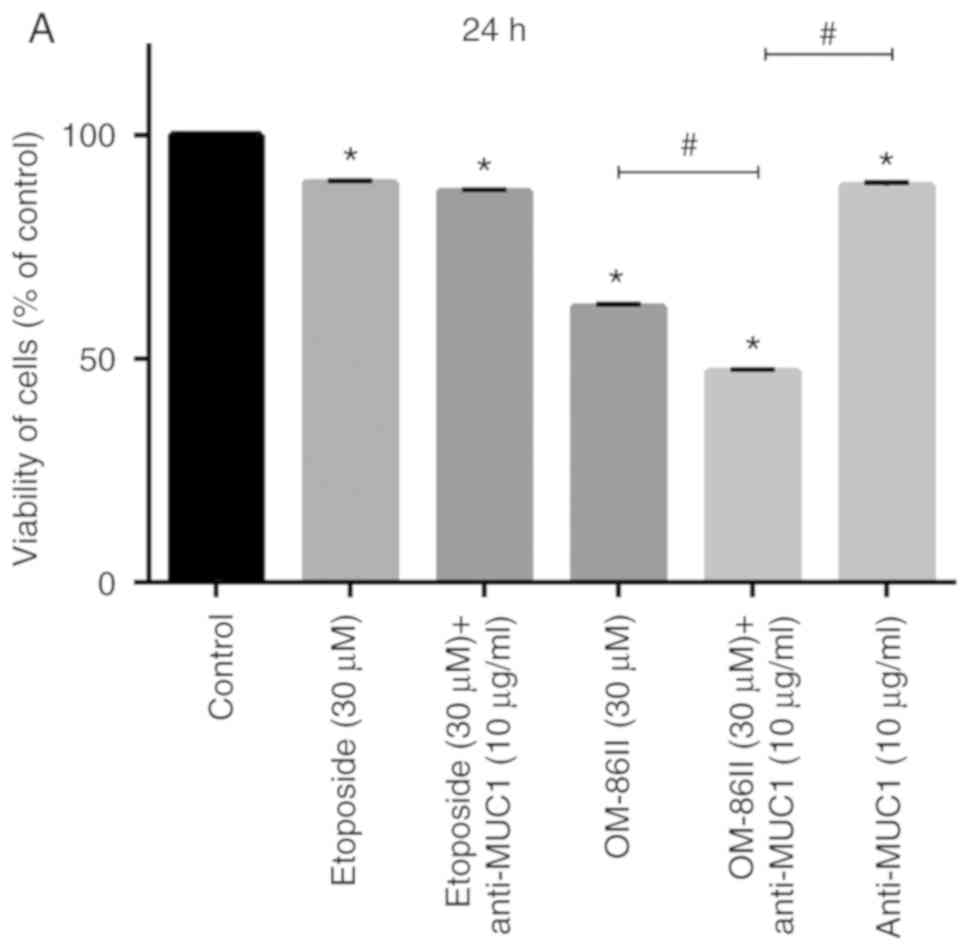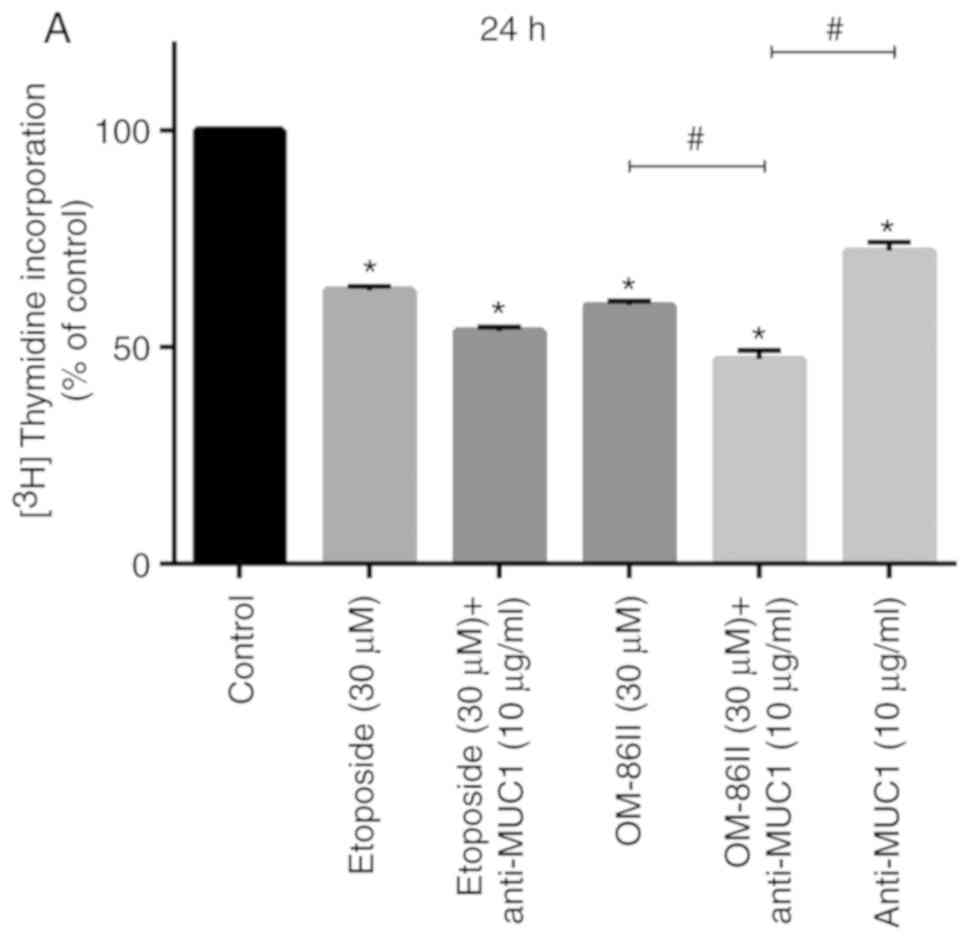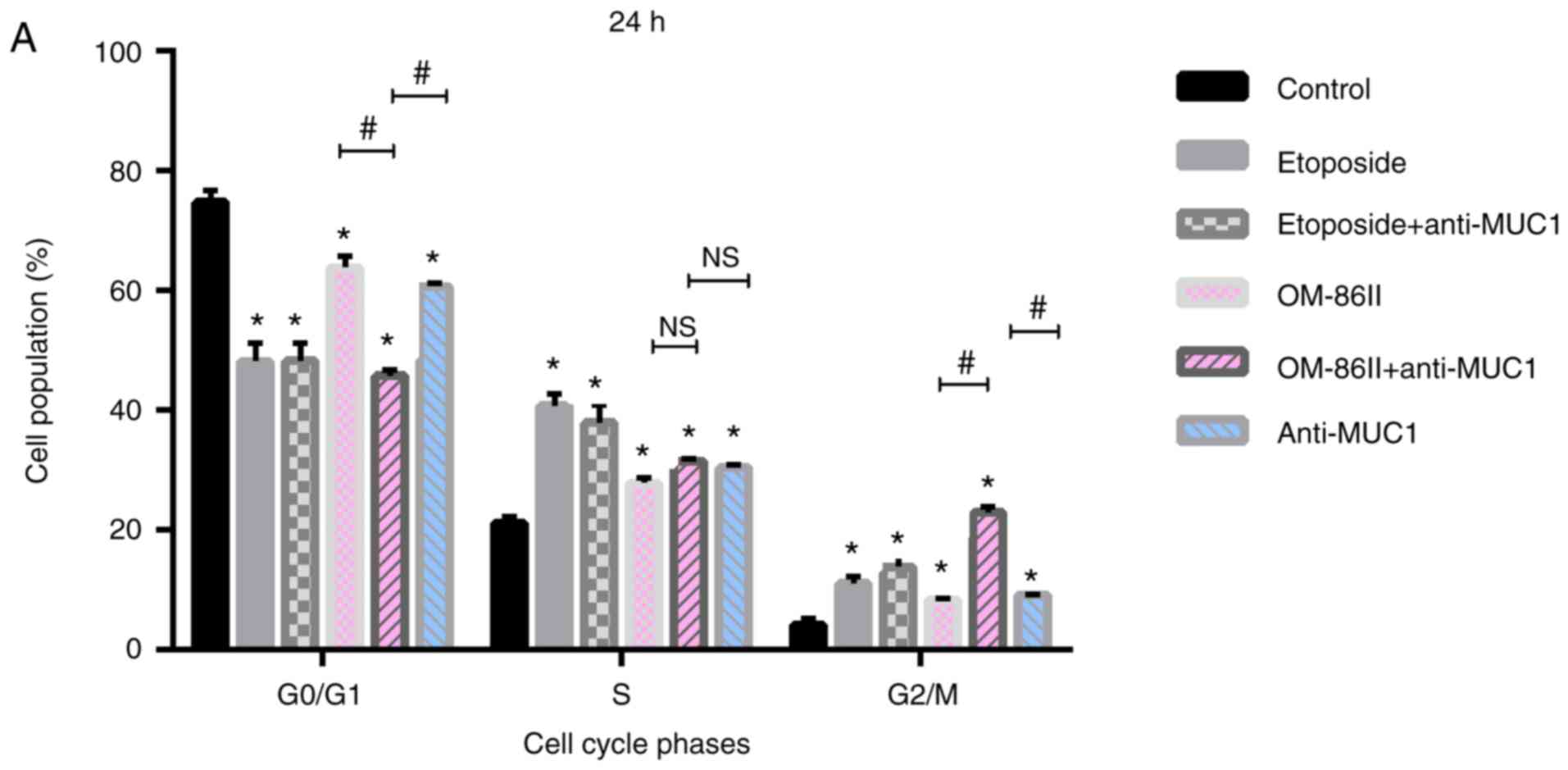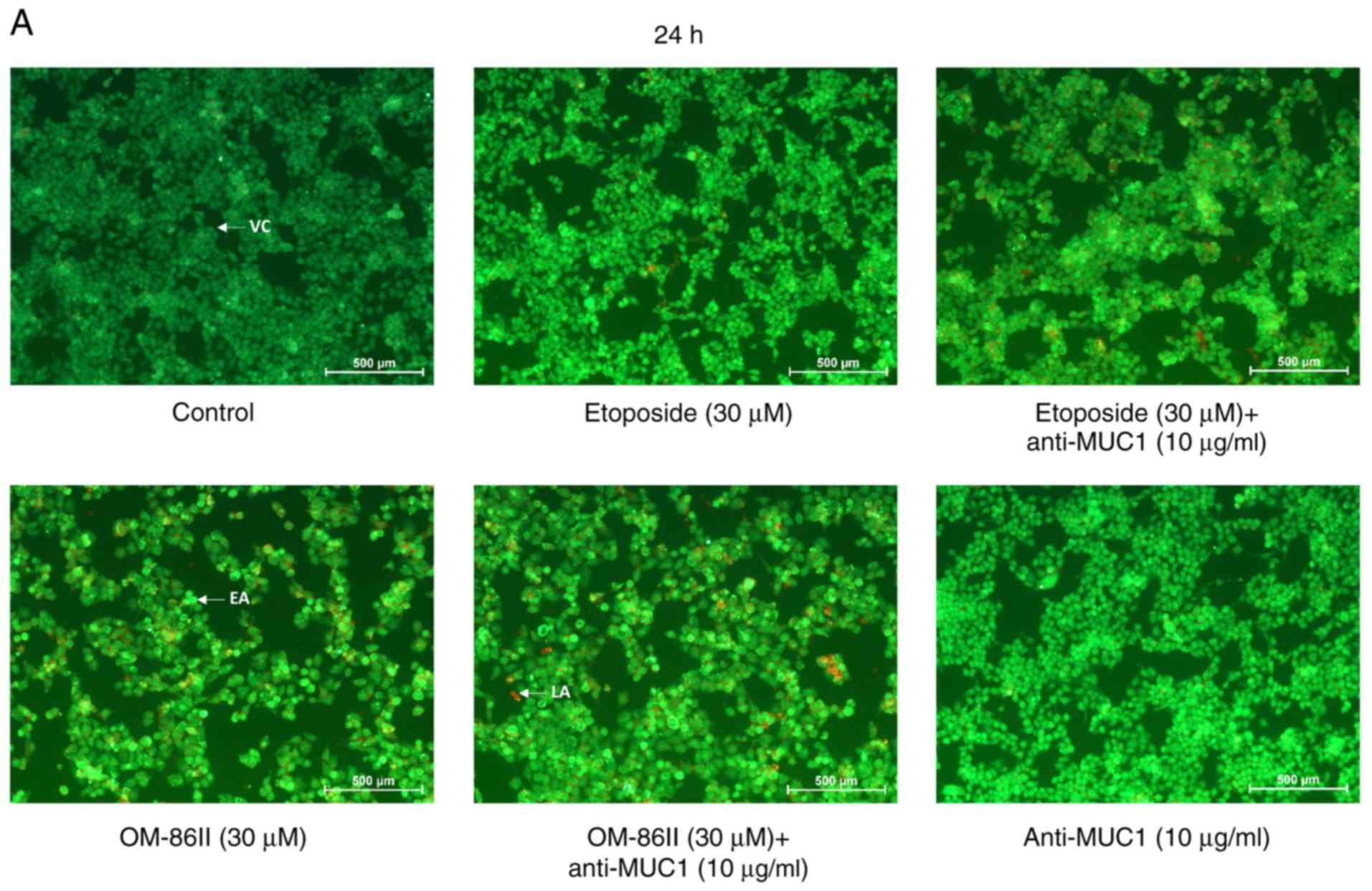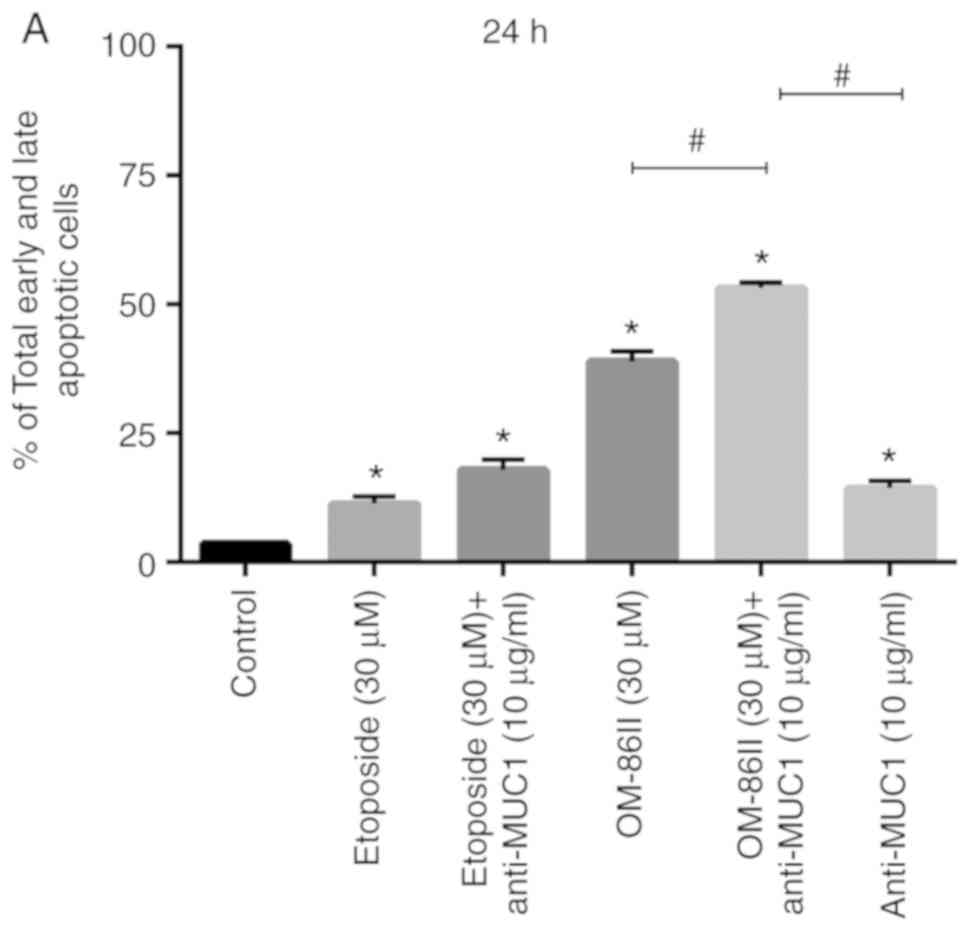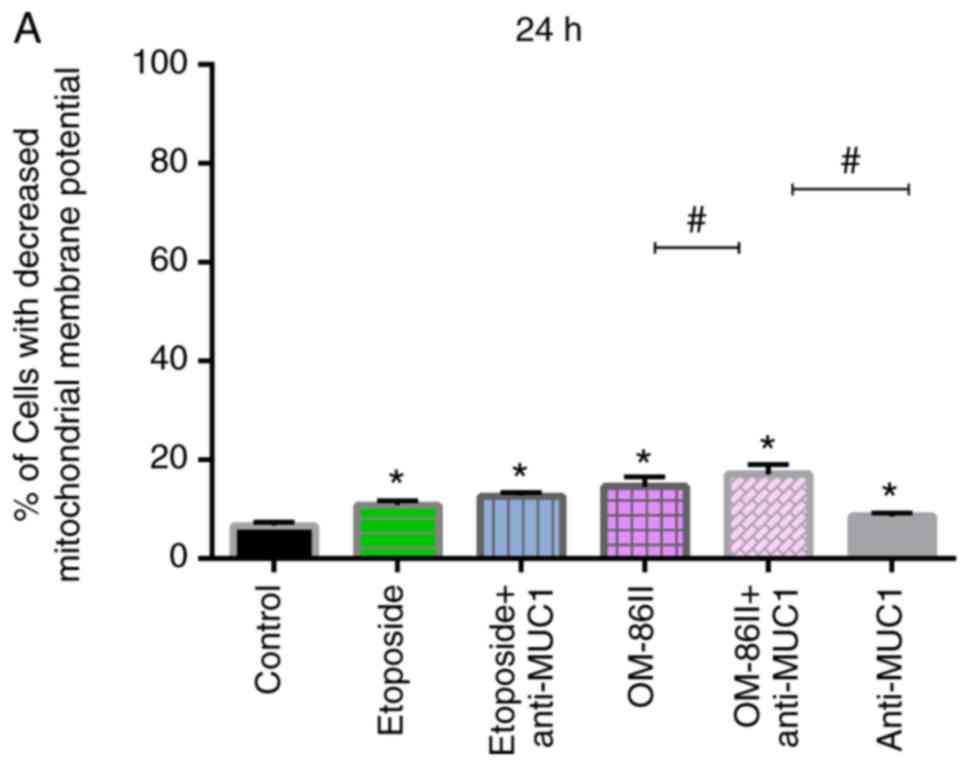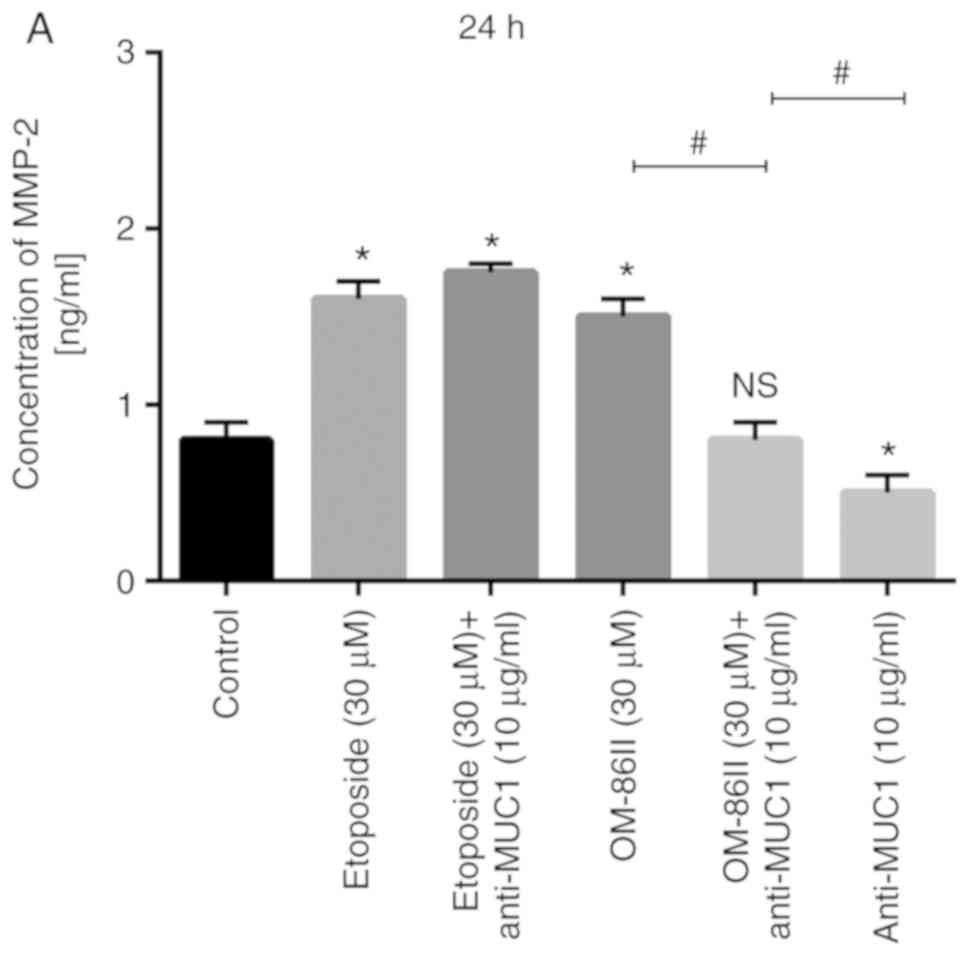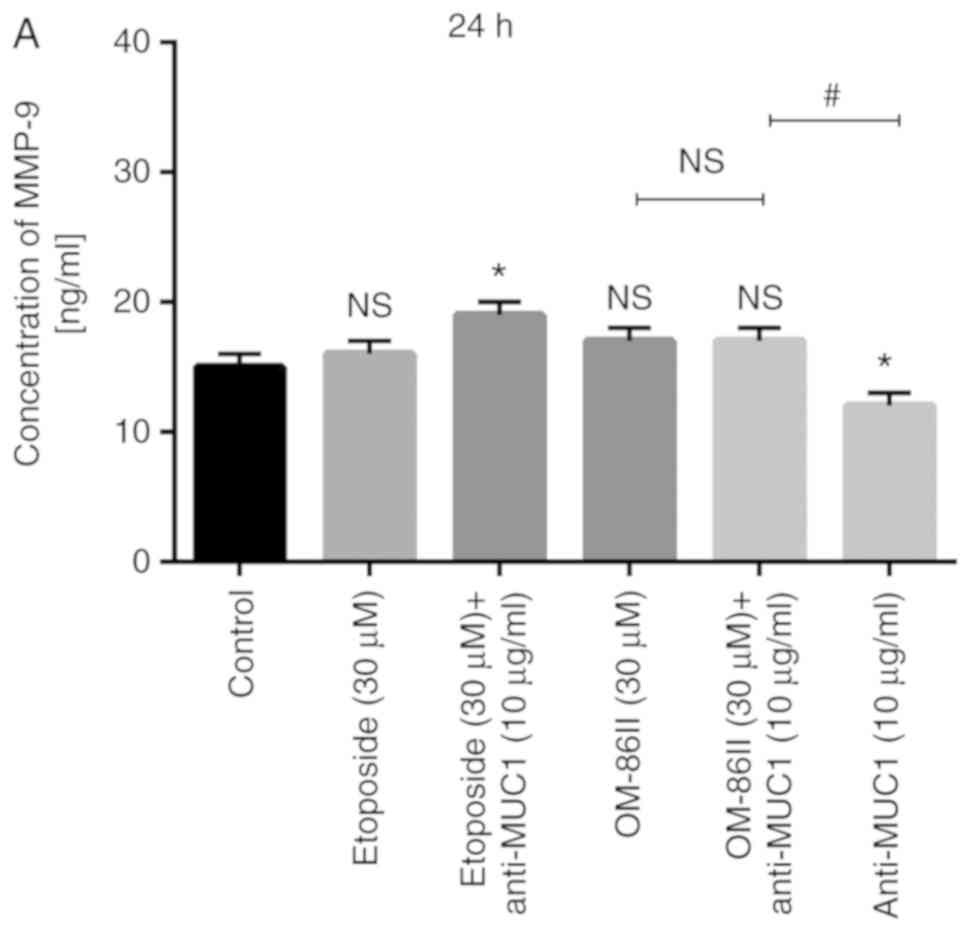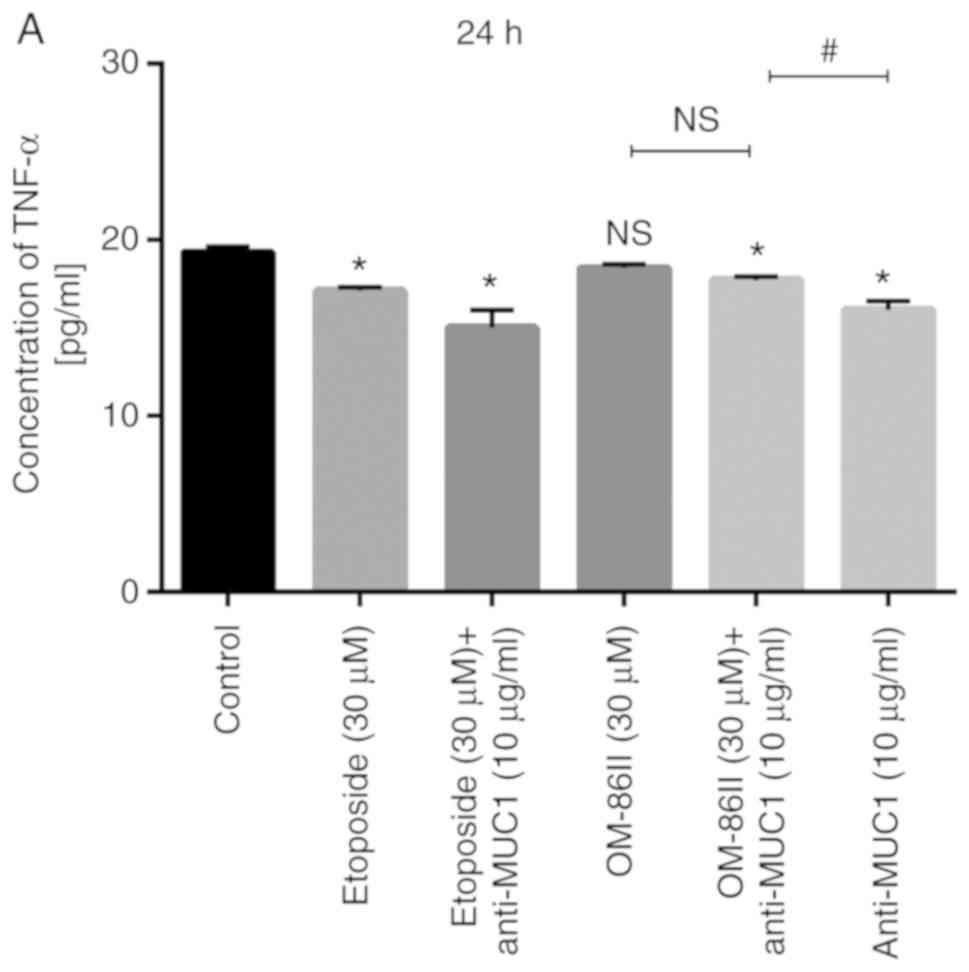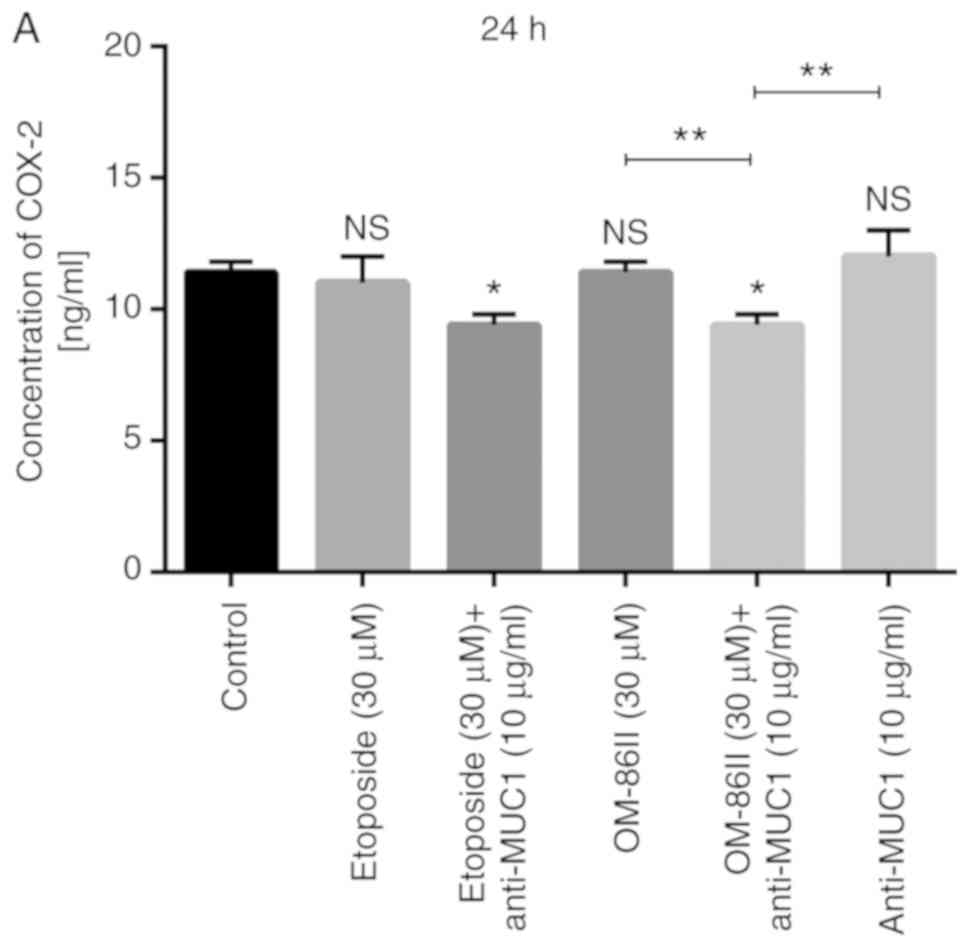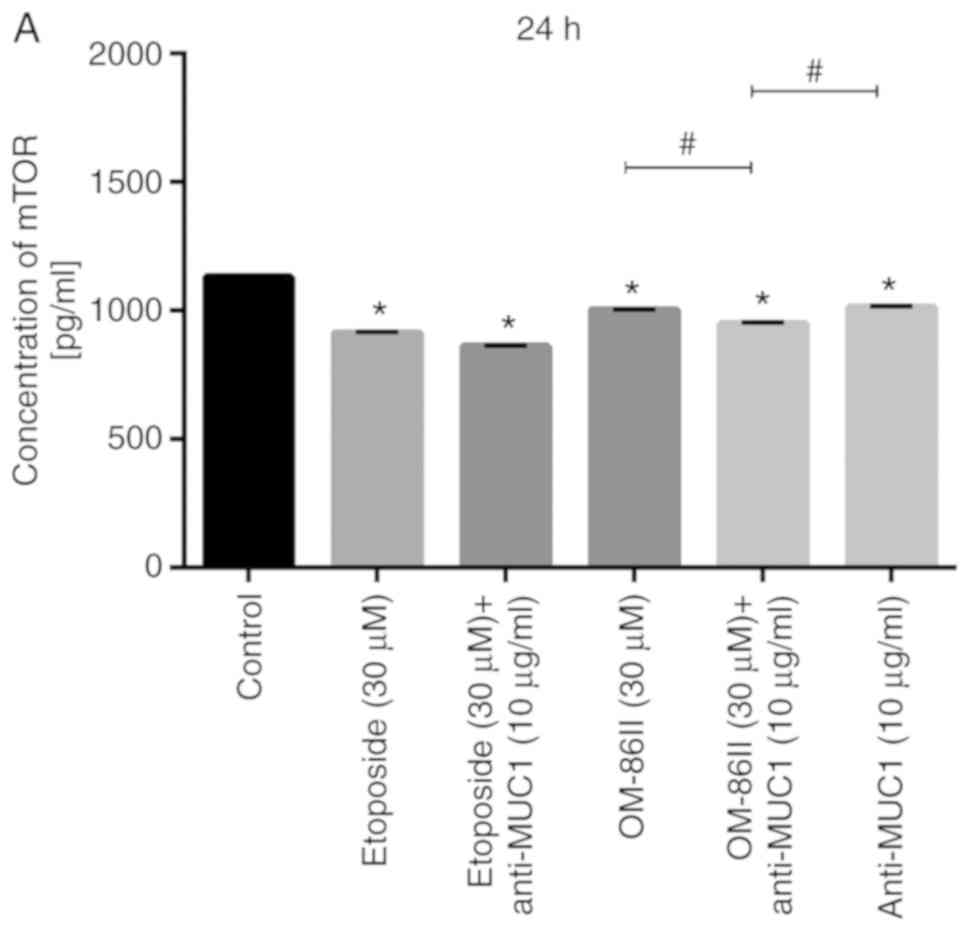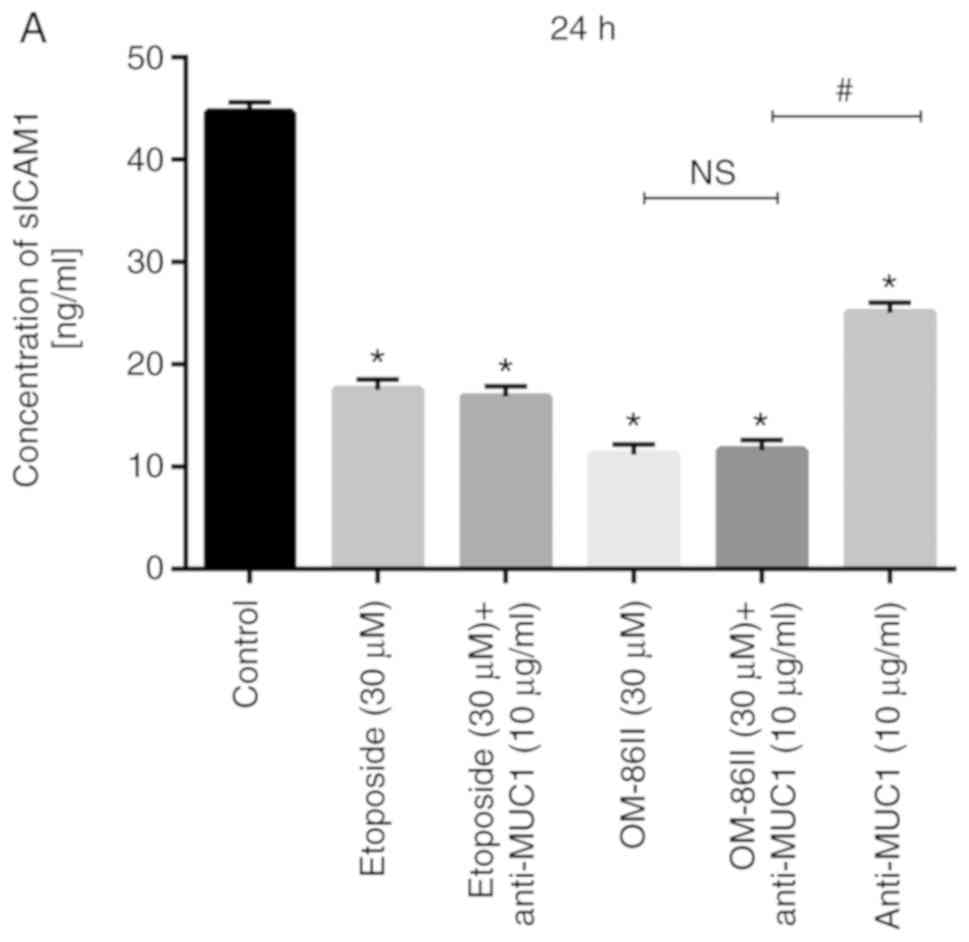|
1
|
Anderson WF, Chatterjee N, Ershler WB and
Brawley OW: Estrogen receptor breast cancer phenotypes in the
surveillance, epidemiology, and end results database. Breast Cancer
Res Treat. 76:27–36. 2002. View Article : Google Scholar : PubMed/NCBI
|
|
2
|
Cleator SJ, Ahamed E, Coombes R and
Palmieri CA: A 2009 update on the treatment of patients with
hormone receptor-positive breast cancer. Clin Breast Cancer 9
Suppl. 1:S6–S17. 2009. View Article : Google Scholar
|
|
3
|
Davies E and Hiscox S: New therapeutic
approaches in breast cancer. Maturitas. 68:121–128. 2011.
View Article : Google Scholar : PubMed/NCBI
|
|
4
|
Nath S and Mukherjee P: MUC1: A
multifaceted oncoprotein with a key role in cancer progression.
Trends Mol Med. 20:332–342. 2014. View Article : Google Scholar : PubMed/NCBI
|
|
5
|
Krishn SR, Kaur S, Smith LM, Johansson SL,
Jain M, Patel A, Gautam SK, Hollingsworth MA, Mandel U, Clausen H,
et al: Mucins and associated glycan signatures in colon
adenoma-carcinoma sequence: Prospective pathological implication(s)
for early diagnosis of colon cancer. Cancer Lett. 374:304–314.
2016. View Article : Google Scholar : PubMed/NCBI
|
|
6
|
Hanson RL and Hollingsworth MA: Functional
consequences of differential O-glycosylation of MUC1, MUC4, and
MUC16 (downstream effects on signaling). Biomolecules. 6:E342016.
View Article : Google Scholar : PubMed/NCBI
|
|
7
|
Cascio S and Finn OJ: Intra- and
extra-cellular events related to altered glycosylation of MUC1
promote chronic inflammation, tumor progression, invasion, and
metastasis. Biomolecules. 6:E392016. View Article : Google Scholar : PubMed/NCBI
|
|
8
|
Pawłowska N, Gornowicz A, Bielawska A,
Surażyński A, Szymanowska A, Czarnomysy R and Bielawski K: The
molecular mechanism of anticancer action of novel
octahydropyrazino[2,1-a:5,4-a′]diisoquinoline derivatives in human
gastric cancer cells. Invest New Drugs. 36:970–984. 2018.
View Article : Google Scholar : PubMed/NCBI
|
|
9
|
Gornowicz A, Pawłowska N, Czajkowska A,
Czarnomysy R, Bielawska A, Bielawski K, Michalak O,
Staszewska-Krajewska O and Kałuża Z: Biological evaluation of
octahydropyrazin[2,1-a:5,4-a′]diisoquinoline derivatives as potent
anticancer agents. Tumour Biol. 39:10104283177016412017. View Article : Google Scholar : PubMed/NCBI
|
|
10
|
Cuya SM, Bjornsti MA and van Waardenburg
RCAM: DNA topoisomerase-targeting chemotherapeutics: What's new?
Cancer Chemother Pharmacol. 80:1–14. 2017. View Article : Google Scholar : PubMed/NCBI
|
|
11
|
Kałuża Z, Bielawski K, Ćwiek R, Niedziejko
P and Kaliski P: C2-symmetric hemiaminal ethers and diamines: New
ligands for copper-catalyzed desymmetrization of meso-1,2-diols and
asymmetric Henry reactions. Tetrahedron Asymmetry. 24:1435–1442.
2013. View Article : Google Scholar
|
|
12
|
Carmichael J, DeGraff WG, Gazdar AF, Minna
JD and Mitchell JB: Evaluation of a tetrazolium-based semiautomated
colorimetric assay: Assessment of radiosensitivity. Cancer Res.
47:943–946. 1987.PubMed/NCBI
|
|
13
|
Czarnomysy R, Surażyński A, Muszynska A,
Gornowicz A, Bielawska A and Bielawski K: A novel series of
pyrazole-platinum(II) complexes as potential anti-cancer agents
that induce cell cycle arrest and apoptosis in breast cancer cells.
J Enzyme Inhib Med Chem. 33:1006–1023. 2018. View Article : Google Scholar : PubMed/NCBI
|
|
14
|
Singh SK, Moretta D, Almaguel F, Wall NR,
De León M and De León D: Differential effect of proIGF-II and
IGF-II on resveratrol induced cell death by regulating surviving
cellular localization and mitochondrial depolarization in breast
cancer cells. Growth Factors. 25:363–372. 2007. View Article : Google Scholar : PubMed/NCBI
|
|
15
|
Gornowicz A, Bielawska A, Czarnomysy R,
Gabryel-Porowska H, Muszyńska A and Bielawski K: The combined
treatment with novel platinum(II) complex and anti-MUC1 increases
apoptotic response in MDA-MB-231 breast cancer cells. Mol Cell
Biochem. 408:103–113. 2015. View Article : Google Scholar : PubMed/NCBI
|
|
16
|
Gordon JL, Brown MA and Reynolds MM:
Cell-based methods for determination of efficacy for candidate
therapeutics in the clinical management of cancer. Diseases.
6:E852018. View Article : Google Scholar : PubMed/NCBI
|
|
17
|
Hugo HJ, Saunders C, Ramsay RG and
Thompson EW: New insights on COX-2 in chronic inflammation driving
breast cancer growth and metastasis. J Mammary Gland Biol
Neoplasia. 20:109–119. 2015. View Article : Google Scholar : PubMed/NCBI
|
|
18
|
Romieu-Mourez R, François M, Abate A,
Boivin MN, Birman E, Bailey D, Bramson JL, Forner K, Young YK,
Medin JA and Galipeau J: Mesenchymal stromal cells expressing
ErbB-2/neu elicit protective antibreast tumor immunity in vivo,
which is paradoxically suppressed by IFN-gamma and tumor necrosis
factor-alpha priming. Cancer Res. 70:7742–7747. 2010. View Article : Google Scholar : PubMed/NCBI
|
|
19
|
Warren MA, Shoemaker SF, Shealy DJ, Bshar
W and Ip MM: Tumor necrosis factor deficiency inhibits mammary
tumorigenesis and a tumor necrosis factor neutralizing antibody
decreases mammary tumor growth in neu/erbB2 transgenic mice. Mol
Cancer Ther. 8:2655–2663. 2009. View Article : Google Scholar : PubMed/NCBI
|
|
20
|
Houghton J, Li H, Fan X, Liu Y, Liu JH,
Rao VP, Poutahidis T, Taylor CL, Jackson EA, Hewes C, et al:
Mutations in bone marrow-derived stromal stem cells unmask latent
malignancy. Stem Cells Dev. 19:1153–1166. 2010. View Article : Google Scholar : PubMed/NCBI
|
|
21
|
Sangaletti S, Tripodo C, Ratti C, Piconese
S, Porcasi R, Salcedo R, Trinchieri G, Colombo MP and Chiodoni C:
Oncogene-driven intrinsic inflammation induces leukocyte production
of tumor necrosis factor that critically contributes to mammary
carcinogenesis. Cancer Res. 70:7764–7775. 2010. View Article : Google Scholar : PubMed/NCBI
|
|
22
|
Hamaguchi T, Wakabayashi H, Matsumine A,
Sudo A and Uchida A: TNF inhibitor suppresses bone metastasis in a
breast cancer cell line. Biochem Biophys Res Commun. 407:525–530.
2011. View Article : Google Scholar : PubMed/NCBI
|
|
23
|
Rubio MF, Werbajh S, Cafferata EG,
Quaglino A, Coló GP, Nojek IM, Kordon EC, Nahmod VE and Costas MA:
TNF-alpha enhances estrogen-induced cell proliferation of
estrogen-dependent breast tumor cells through a complex containing
nuclear factor-kappa B. Oncogene. 25:1367–1377. 2006. View Article : Google Scholar : PubMed/NCBI
|
|
24
|
Rivas MA, Tkach M, Beguelin W, Proietti
CJ, Rosemblit C, Charreau EH, Elizalde PV and Schillaci R:
Transactivation of ErbB-2 induced by tumor necrosis factor alpha
promotes NF-kappaB activation and breast cancer cell proliferation.
Breast Cancer Res Treat. 122:111–124. 2010. View Article : Google Scholar : PubMed/NCBI
|
|
25
|
Rivas MA, Carnevale RP, Proietti CJ,
Rosemblit C, Beguelin W, Salatino M, Charreau EH, Frahm I, Sapia S,
Brouckaert P, et al: TNF alpha acting on TNFR1 promotes breast
cancer growth via p42/P44 MAPK, JNK, Akt and NF-kappa B-dependent
pathways. Exp Cell Res. 314:509–529. 2008. View Article : Google Scholar : PubMed/NCBI
|
|
26
|
Saal LH, Johansson P, Holm K,
Gruvberger-Saal SK, She QB, Maurer M, Koujak S, Ferrando AA,
Malmström P, Memeo L, et al: Poor prognosis in carcinoma is
associated with a gene expression signature of aberrant PTEN tumor
suppressor pathway activity. Proc Natl Acad Sci USA. 104:7564–7569.
2007. View Article : Google Scholar : PubMed/NCBI
|
|
27
|
Engelman JA: Targeting PI3K signalling in
cancer: Opportunities, challenges and limitations. Nat Rev Cancer.
9:550–562. 2009. View Article : Google Scholar : PubMed/NCBI
|
|
28
|
Ciruelos Gil EM: Targeting the
PI3K/AKT/mTOR pathway in estrogen receptor-positive breast cancer.
Cancer Treat Rev. 40:862–871. 2014. View Article : Google Scholar : PubMed/NCBI
|
|
29
|
Horm TM and Schroeder JA: MUC1 and
metastatic cancer: Expression, function and therapeutic targeting.
Cell Adh Migr. 7:187–198. 2013. View Article : Google Scholar : PubMed/NCBI
|
|
30
|
Shen Q, Rahn JJ, Zhang J, Gunasekera N,
Sun X, Shaw AR, Hendzel MJ, Hoffman P, Bernier A and Hugh JC: MUC1
initiates Src-CrkLRac1/Cdc42-mediated actin cytoskeletal protrusive
motility after ligating intercellular adhesion molecule-1. Mol
Cancer Res. 6:555–567. 2008. View Article : Google Scholar : PubMed/NCBI
|
|
31
|
Sachdeva M and Mo YY: MicroRNA-145
suppresses cell invasion and metastasis by directly targeting mucin
1. Cancer Res. 70:378–387. 2010. View Article : Google Scholar : PubMed/NCBI
|
|
32
|
Wei X, Xu H and Kufe D: MUC1 oncoprotein
stabilizes and activates estrogen receptor alpha. Mol Cell.
21:295–305. 2006. View Article : Google Scholar : PubMed/NCBI
|
|
33
|
Woo JK, Choi Y, Oh SH, Jeong JH, Choi DH,
Seo HS and Kim CW: Mucin 1 enhances the tumor angiogenic response
by activation of the AKT signaling pathway. Oncogene. 31:2187–2198.
2012. View Article : Google Scholar : PubMed/NCBI
|
|
34
|
Mikami Y, Hisatsune A, Tashiro T, Isohama
Y and Katsuki H: Hypoxia enhances MUC1 expression in a lung
adenocarcinoma cell line. Biochem Biophys Res Commun.
379:1060–1065. 2009. View Article : Google Scholar : PubMed/NCBI
|
|
35
|
Fessler SP, Wotkowicz MT, Mahanta SK and
Bamdad C: MUC1* is a determinant of trastuzumab (Herceptin)
resistance in breast cancer cells. Breast Cancer Res Treat.
118:113–124. 2009. View Article : Google Scholar : PubMed/NCBI
|
|
36
|
Pillai K, Pourgholami MH, Chua TC and
Morris DL: MUC1 as a potential target in anticancer therapies. Am J
Clin Oncol. 38:108–118. 2015. View Article : Google Scholar : PubMed/NCBI
|
|
37
|
Etti IC, Abdullah R, Kadir A, Hashim NM,
Yeap SK, Imam MU, Ramli F, Malami I, Lam KL, Etti U, et al: The
molecular mechanism of the anticancer effect of Artonin E in MDA-MB
231 triple negative breast cancer cells. PLoS One. 12:e01823572017.
View Article : Google Scholar : PubMed/NCBI
|
|
38
|
Kim SH, Turnbull J and Guimond S:
Extracellular matrix and cell signalling: The dynamic cooperation
of integrin, proteoglycan and growth factor receptor. J Endocrinol.
209:139–151. 2011. View Article : Google Scholar : PubMed/NCBI
|
|
39
|
Walker C, Mojares E and Del Río Hernández
A: Role of extracellular matrix in development and cancer
progression. Int J Mol Sci. 19:E30282018. View Article : Google Scholar : PubMed/NCBI
|
|
40
|
Jena MK and Janjanam J: Role of
extracellular matrix in breast cancer development: A brief update.
Version 2 F1000Res. 7:2742018. View Article : Google Scholar
|
|
41
|
Fingleton B: Matrix metalloproteinases:
Roles in cancer and metastasis. Front Biosci. 11:479–491. 2006.
View Article : Google Scholar : PubMed/NCBI
|
|
42
|
Leppä S, Saarto T, Vehmanen L, Blomqvist C
and Elomaa I: A high serum matrix metalloproteinase-2 level is
associated with an adverse prognosis in node-positive breast
carcinoma. Clin Cancer Res. 10:1057–1063. 2004. View Article : Google Scholar : PubMed/NCBI
|
|
43
|
Huang H: Matrix metalloproteinase-9
(MMP-9) as a cancer biomarker and MMP-9 biosensors: Recent
advances. Sensors (Basel). 18:E32492018. View Article : Google Scholar : PubMed/NCBI
|
|
44
|
Pellikainen JM, Ropponen KM, Kataja VV,
Kellokoski JK, Eskelinen MJ and Kosma VM: Expression of matrix
metalloproteinase (MMP)-2 and MMP-9 in breast cancer with a special
reference to activator protein-2, HER2, and prognosis. Clin Cancer
Res. 10:7621–7628. 2004. View Article : Google Scholar : PubMed/NCBI
|
|
45
|
Di Cara G, Marabeti MR, Musso R, Riili I,
Cancemi P and Pucci Minafra I: New insights into the occurrence of
matrix metalloproteases −2 and −9 in a cohort of breast cancer
patients and proteomic correlations. Cells. 7:E892018. View Article : Google Scholar : PubMed/NCBI
|
|
46
|
Katanov C, Lerrer S, Liubomirski Y,
Leider-Trejo L, Meshel T, Bar J, Feniger-Barish R, Kamer I,
Soria-Artzi G, Kahani H, et al: Regulation of the inflammatory
profile of stromal cells in human breast cancer: Prominent roles
for TNF-α and the NF-κB pathway. Stem Cell Res Ther. 6:872015.
View Article : Google Scholar : PubMed/NCBI
|
|
47
|
Hosseini F, Hassannia H, Mahdian-Shakib A,
Jadidi-Niaragh F, Enderami SE, Fattahi M, Anissian A, Mirshafiey A
and Kokhaei P: Targeting of crosstalk between tumor and tumor
microenvironment by β-D mannuronic acid (M2000) in murine breast
cancer model. Cancer Med. 6:640–650. 2017. View Article : Google Scholar : PubMed/NCBI
|
|
48
|
Miller TW, Rexer BN, Garrett JT and
Arteaga CL: Mutations in the phosphatidylinositol 3-kinase pathway:
Role in tumor progression and therapeutic implications in breast
cancer. Breast Cancer Res. 13:2242011. View Article : Google Scholar : PubMed/NCBI
|
|
49
|
Rahn JJ, Chow JW, Horne GJ, Mah BK,
Emerman JT, Hoffman P and Hugh JC: MUC1 mediates transendothelial
migration in vitro by ligating endothelial cell ICAM-1. Clin Exp
Metastasis. 22:475–483. 2005. View Article : Google Scholar : PubMed/NCBI
|
|
50
|
Thielemann A, Baszczuk A, Kopczyński Z,
Nowak A and Grodecka-Gazdecka S: The clinical usefulness of
assessing the concentration of cell adhesion molecules sVCAM-1 and
sICAM-1 in the serum of women with primary breast cancer. Contemp
Oncol (Pozn). 18:252–259. 2014.PubMed/NCBI
|
|
51
|
Gornowicz A, Kałuża Z, Bielawska A,
Gabryel-Porowska H, Czarnomysy R and Bielawski K: Cytotoxic
efficacy of a novel dinuclear platinum(II) complex used with
anti-MUC1 in human breast cancer cells. Mol Cell Biochem.
392:161–174. 2014. View Article : Google Scholar : PubMed/NCBI
|
|
52
|
Wang L, Chen H, Pourgholami MH, Beretov J,
Hao J, Chao H, Perkins AC, Kearsley JH and Li Y: Anti-MUC1
monoclonal antibody (C595) and docetaxel markedly reduce tumor
burden and ascites, and prolong survival in an in vivo ovarian
cancer model. PLoS One. 6:e244052011. View Article : Google Scholar : PubMed/NCBI
|
|
53
|
Slamon DJ, Leyland-Jones B, Shak S, Fuchs
H, Paton V, Bajamonde A, Fleming T, Eiermann W, Wolter J, Pegram M,
et al: Use of chemotherapy plus a monoclonal antibody against HER2
for metastatic breast cancer that overexpresses HER2. N Engl J Med.
344:783–792. 2001. View Article : Google Scholar : PubMed/NCBI
|
|
54
|
Raina D, Uchida Y, Kharbanda A, Rajabi H,
Panchamoorthy G, Jin C, Kharbanda S, Scaltriti M, Baselga J and
Kufe D: Targeting the MUC1-C oncoprotein downregulates HER2
activation and abrogates trastuzumab resistance in breast cancer
cells. Oncogene. 33:3422–3431. 2014. View Article : Google Scholar : PubMed/NCBI
|
















